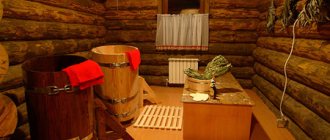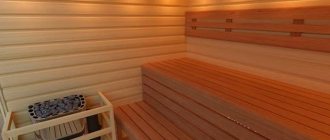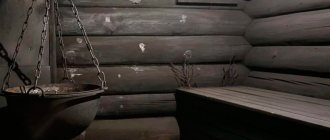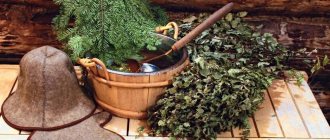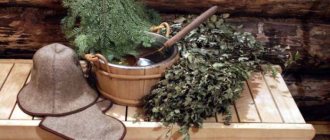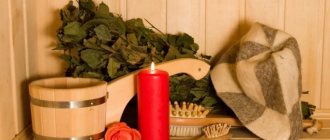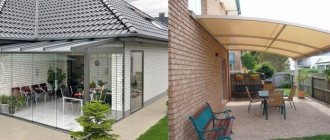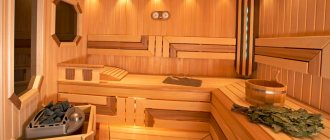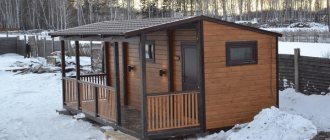Author: Mithun Chakrabortenkov
25 September 2022 12:12
Tags: healthy DIY Russian sauna with light steam
6147
10
The Russian bath does not tolerate fuss. And you need to steam regularly, preparing your body to accept certain procedures. We sweat until we sweat. It takes all day. Russian bath day. The founder of the direction is bath master Georgy Borisovich Dobrovolsky.
0
See all photos in the gallery
The well-known health formula “keep your feet warm, your stomach hungry, and your head cold” applies primarily to guests of a Russian steam bath. “A good bath is better than a hearty lunch!” Therefore, we come there only on an empty stomach, after visiting the toilet and freshening up with a warm shower. We always keep our feet warm. You should warm your feet before entering the steam room or, lying on a bath shelf, by lowering them into a bowl of hot water. We always breathe only through our nose.
×
0
FIRST APPROACH TO THE BATH SHELF
Lying in the soft fragrant warmth, we return to our dear and serene childhood. The chilled soul thaws, the tired body is filled with life-giving warmth. Our heat center is the liver, the stove involved in hematopoiesis and purification of our blood. We help her warm up by stroking and steaming the liver area with a live birch or oak broom with delicious steam. This continues until the heart, responding to the thermal load, wants to rest with us and leave the steam room. The Russian bathhouse should only be enjoyed! The feeling of discomfort is eliminated by appropriate equalization of the steam-air environment “hot-warm-cool”. There is a phenomenon of the Russian steam room: “the body loves warmth, and the soul loves coolness.” The body is bathed in hot aromas, and we breathe “deliciously” and easily through a chilled bath broom, covering our face with it. During our entire stay in the steam room, terry sheets hang next to us, keeping us warm and dry. Thanks to this, when we leave the steam room, we always cover our sweaty and hot body with a dry and warm sheet. Relaxing in the living room after the first visit to the shelves. Coming out of the steam room and washing off the sweat in the hot shower, we relax in the living room at the sauna table. We do this sitting or lying down. The sheet retains our body heat longer and we continue to sweat. Thirst should never be tolerated, especially on our bath day. Fragrant herbal tea and hot honey sbitni are drunk in small sips in the living room, slowly and enjoying. This, and, if desired, a dry foot bath of heated rock salt, maintains a pleasant languor in the body for a long time and creates a feeling of deep peace.
0
Who reconstructed the baths
The development of Lanterns is being carried out by entrepreneurs Grigory Musil and Alexander Davidan, who also run the famous Tar Baths in the center of St. Petersburg.
When restoring the building, the contractors relied on neo-Russian style and high-quality materials. The authors wanted to restore the building to its original form, and also, if possible, return the decor and add only what was organic to the 19th century.
For example, an unpreserved fireplace in the Louis XVI style in the women's room was replaced by an antique model from the same times, ordered from France.
During the restoration, the famous steam rooms were preserved, and the stoves were repaired without making changes to the design. Some historical interiors were recreated, and the tiled fireplace in the men's classroom was restored.
The image of the updated “Lanterns” was created by the design bureau Megre Interiors together with the ideological leader of the renovation project Artyom Shakhnazarov.
We talked with Artyom about the effort it takes to restore a 150-year-old building and adapt the architectural design of the last century to new engineering realities.
1 / 2
The building of the baths before restoration
2 / 2
Baths after restoration
SECOND APPROACH TO THE BATH SHELF
After the body has cooled down and the sweat on it has dried, we return to the steam room, increasingly using the heater and fanning, stroking and steaming our body with a broom, warming it up more and more. At the same time, peripheral blood circulation is gradually activated, breathing deepens and heart function increases. After a good warm-up, we wash off the sweat in a hot shower and, without covering ourselves with a bath sheet, go out to the hydromassage department. Mustard-salt ladka - rubbing after the second visit to the shelf On a warm massage trestle bed, well doused with boiling water, we, independently or with the help of a bath attendant, begin an extremely important and at the same time enjoyable bath procedure. With a mixture of ordinary table salt and mustard powder, moistened with bread kvass, or clean water, we thoroughly and thoroughly rub all the skin of the body with the exception of the face and eyes. In this way, the body is cleansed of dead layers of the dermis along with all its impurities, sweat, and sebum. At the same time, the skin is sterilized, freed from all pathogenic bacteria, while simultaneously stimulating all its physiological functions. Skin circulation is activated, and the osmotic effect of the salt solution on the body supports sweating. Having finished rubbing, we immediately or after resting until the salt dries on the body, we return without washing the salt from the body to the bathhouse shelf.
0
Cold bath in Tsarskoe Selo
Peter Neelov. Plan of the second floor of the Cold Baths and adjacent parts of the complex. 1797. Image: a-park.rf
Cameron Gallery. Tsarskoe Selo, St. Petersburg. Architect Charles Cameron. 1779–1787. Photo: spbhi.ru
Part of the platform and descent near the agate rooms. Tsarskoe Selo, St. Petersburg. Architect Charles Cameron. 1779–1787. Photo: Nikolay Matveev / citywalls.ru
It was built for Catherine II by the Scottish architect Charles Cameron, author of the book “The Baths of the Romans.” The Empress wanted to have in her residence “a project of an antique house, laid out as in antiquity” and invited the “great draftsman” Cameron to Russia. Thus, in Tsarskoe Selo, by 1794, an ensemble in the spirit of classicism had grown up: through the Hanging Garden, Catherine II walked directly from her chambers to the Cold Bath, walked along the colonnade of the Cameron Gallery, and went down the Ramp to the park.
The baths were created in the image of Roman baths of the 4th century. On the lower floor Cameron placed the Bathing Hall with a tin pool. Also downstairs there was a Russian bathhouse (steam in it was produced by 250 cannonballs, which were poured with water), a bathroom, and a massage room in the corner. The recreation room was decorated with an “antique bed” and a white marble fireplace.
On the top floor there were offices, a library, and a Great Hall. The Empress ordered them to be decorated with minerals - the entire decoration took 25 tons of marble and multi-colored jasper.
Catherine II was critical of the completed project. She wrote to her secretary Alexander Khrapovitsky: “It’s strange that the entire building for the bathhouse was built, but the bathhouse turned out to be thin, you can’t wash in it.” The Empress bathed more often in the Upper and Lower Baths near the Square Ponds.
During the Great Patriotic War, the Germans built a casino and an officers' club in the building and tore out the jasper from the walls. The cold bath was restored in 1947–1948, and the jasper decoration was completely returned in 2013. Today you can go there with a ticket from the Tsarskoye Selo State Museum-Reserve.
THIRD APPROACH TO THE BATH SHELF
The presence of table salt on the body in combination with the vigorous salty steam in the steam room (for this we specially add a solution of sea salt in hot water to the heater) creates an extremely beneficial environment. Active cleansing of the body begins through all the skin, nasopharynx and lungs. The salty steam-air mixture we inhale organically and easily rejects the mucus and phlegm accumulated on the mucous membranes and membranes. And now the time has come for a real parka, our original Russian bath-broom massage! Through young, already cleansed skin, profuse sweat continues to rid the body of metabolic products, toxins and many impurities. Hot soapy birch massage after the third visit to the shelves. This is a continuation of the revival of the youth of our body. Having washed off the sweat in a hot shower and doused ourselves with cool water to freshen up but not cool the body, we return to the hydromassage department on a clean, heated massage table. The last, but equally enjoyable cleansing procedure is carried out with hot, well-whipped soapy foam with a fresh birch bath broom. Brooms made from other types of wood are not suitable for this purpose. To maintain a high temperature, the bucket of foam must be in a vat of boiling water, into which a bath broom is also dipped before starting work. Along with rubbing the body, which is performed both softly and with force, especially with a dotted, intermittent drawing of a broom over the body with weights from the hand of a massage therapist, other massage techniques are also used, but affecting the body through the broom foliage. In this case, it is unacceptable for soap foam to get into the windpipe. The alkali can spasm it until breathing stops completely, so caution is needed. The person’s face is covered with a fragrant broom. As a result of the soap-birch massage, the body acquires a blissful feeling of airy weightlessness and feels like it is easily breathing with rejuvenated skin. The final chords of this action are gentle, very slow dousing of the body, always alternating between very warm and slightly cool water. Begin pouring directionally, from the head to the feet, so that the washed off foam does not get on the face.
0
How were the ancient baths constructed?
The project was expensive, large-scale and innovative. Materials for construction were ordered from Europe: Portland cement, which only became harder when damp, English brick for the construction of stoves, as well as tiles and a French fireplace from the time of Louis XVI.
Lantern baths in Soviet times
The baths were equipped with the latest technology: it was possible to regulate the temperature and water level in the marble pools, and the air came from the street already warm.
Pavel Syuzor
However, despite the ultimate luxury, the baths were accessible to almost everyone: according to the laws of the 19th century, each bath had to provide services of different classes at a price of three kopecks per entrance.
Having become the first public baths with standard sanitary conditions, in Soviet times the Lanterns wore a modest number 43, but were no less in demand: they retained their reputation as a luxurious place, and the luster of the pre-revolutionary decoration had not yet been completely lost. However, by the end of the nineties, the building fell into complete disrepair, was declared unsafe and a few years later was taken under the protection of KGIOP.
FOURTH APPROACH TO THE BATH SHELF
“If you steam your bones, you’ll fix your whole body!” The climax of the bath celebration is coming! A fierce battle with yourself! Our skin is cleansed, the body is deeply steamed, the purified hot blood circulates more freely, and we are already in vigorous steam. The time of sweet peace has passed. The time of inspired emotional and physiological recovery is coming. The skin burns, the blood boils, but “the steam doesn’t ache the bones, it doesn’t drive away the soul!” It begins “such a parka that the sky will be hot”, “the bones are softening, all the veins are humming”! Living bone loves warmth, and our goal is to warm up the most intimate part of nature - bones, cartilage, ligaments, tendons and the holy of holies - the hematopoietic red bone marrow! The place where forever young blood stem cells are born and live, which, as is now known, can turn into any other cells to restore damaged tissues of our body. That’s why “the day you steam, you don’t grow old”! People in whose lives the Russian steam room plays a significant role look surprisingly young and healthy even in their old age. Judging by their appearance, activity and mobility, they look twenty to thirty years younger. Bath procedures help strengthen and rejuvenate the senses (eyes, ears, nose, tongue, respiratory system of the entire skin and internal organs). A person becomes fit, energetic and efficient. Strength develops, the spine becomes more flexible, and elasticity appears in the tendons and lumbar muscles. From the bath shocks of a Russian person, “the wisdom of the whole organism and a feeling of inner freedom awaken in it.” So, having warmed up powerfully and deeply, we move on to contrasting procedures - diving into a cold pool, an ice hole or a snowdrift. Having emerged naked from the steam room and quickly washed off the sweat in a hot shower, we dive into the pool. We dive sharply, only in this case is rapid and simultaneous spasm of the entire peripheral circulatory system achieved. Pure hot blood quickly flows into our body, washing and healing the entire body. Taking a deep breath before jumping, we slowly and continuously exhale the air and jump into the pool in a “sitting” position. At the same time, we stretch our legs horizontally forward, and our arms to the sides. This achieves a slight slowdown in the descent to the bottom of the pool. Having cooled down in this way, we should not feel cold, but restore the warmth in a hot shower or by briefly returning to the steam room. All this is repeated again and again, until “the soul yearns for space” and feels the delight and joy of being.
0
Types of baths by origin
The spread of baths was of a “multi-focal” migration nature, as evidenced by even their very names, which also came to us from the distant past. Some have already become obsolete, while others still exist.
So, baths are divided into such “nationalities” as:
- Finnish (sauna);
- ancient (Roman and Greek);
- Japanese (ofuro, sento);
- Chinese;
- Russian bath);
- Turkish (hammam);
- Western European;
- Egyptian;
- Indian;
- African;
- Indian (temazcal);
- Icelandic.
Photo of a Japanese bath.
Note! All of the listed types of baths differ not only in their territorial origin. They can also be classified into dry air (their installation instructions imply that air humidity should not exceed a threshold of 25%), damp air (air humidity from 40 to 75%) and water types (for example, Japanese barrels).
FIFTH APPROACH TO THE BATH SHELF
Lying on the shelf in the fragrant and hot steam, we ourselves or with the help of the bathhouse attendant begin the general cold treatment. To do this, we use a whole arsenal of frozen items, combining the effects of cold and bath heat on the body, rejuvenating, warming and tightening our body. We relax after the fifth visit to the shelves in the living room with fragrant tea.
0
Why “Lantern” baths
In 1863, water supply began operating in St. Petersburg. According to the designs of the architect Pavel Syuzor, public baths began to be built in the city: more than ten “health complexes” were erected. It is important that Suzor viewed them this way: public spaces that solve several problems for a city dweller at once: hygiene, health, pleasant leisure.
On April 23, 1871, exactly 150 years ago, the “People's Baths” in Fonarny Lane were completed and named Voroninsky after their owner, merchant and academician Mikhail Voronin. Among the people, the name “Lanterns” or “Lanterns” quickly stuck to them.
SIXTH APPROACH TO THE BATH SHELF
During the sixth visit to the steam room, we are already calmly relaxing in the gentle, light and fragrant steam. By continuing to sweat lightly, we gradually reduce the heat load on the body. Honey ladkiya - rubbing after the sixth visit to the shelves. Having washed off the sweat in a warm shower, we lie down on a clean, warm massage trestle bed for honey ladkiya - rubbing our body. Honey should be fragrant, soft, and not contain hard crystals. In this case, it is advisable to use 2-3 different types of honey, for example, amazing snow-white honey from white acacia flowers, golden May or linden honey, dark buckwheat honey. Before and after a honey massage, it is pleasant and especially beneficial to drink a glass of flower tea with the same types of honey. This simultaneous use of honey internally and externally gives a special healing effect and great well-being. In this action, it is important that the feet are warm and, if necessary, they can be warmed in a bowl of hot salt water or dry hot salt.
0
Black steam room
The traditional steam room was called “black” and was hot and smoky . A stone stove was placed in the corner of the bathhouse, which heated and smoked heavily. To avoid burning our feet, straw was placed on the floor, as the floor became very hot. Along the walls, trestle beds-shelves were made, and steam lovers lay down or sat on them, enjoying the aromatic, delicious kvass and the smell of straw.
Kvass played a significant role , since it was periodically poured over the brazier, and the steam room was filled with the aroma of the drink, and the air became more humid. Because of the open fireplace, the heat warmed not only the stones, but also the wooden walls. The smoke came out through a vent in the ceiling or through the door. Usually there was a boiler for hot water and a heater made of stones. The bathhouse was heated with wood, preferably hardwood. Z.I. Letunov, in his work “Russian Baths,” reflected the whole essence of those times.
SEVENTH APPROACH TO THE BATH SHELF
Having rested well during and after the naked honey rub, we go to the steam room for the last time. At the same time, the temperature and humidity conditions in it should be maintained as moderate as during the first run (comfortable warmth). This is our last “clean” exit with a feeling of bliss and complete contentment. “The bathhouse fed me, melted all my joints, softened my tight cartilages.” After the seventh visit to the shelves, we wash our hair and dry our rejuvenated body for a long time and thoroughly in post-bath languor. There is no need to rush here. The song of restored health sounds in the body and you don’t want to leave this feeling of celebration within yourself. “No one ever gets sick in a Russian steam bath!” Now you should try to follow the special bath rule. “You should leave the bathhouse with the same humidity and body temperature as when you arrived.” In practice, this position can be performed in cold weather without going outside and taking a good nap in warmth and peace. And this also happens well during a friendly feast, a meal after the end of bathhouse battles. At this meal, Russian dishes are served: delicious and easy on the stomach fish boyar fish soup or large fish baked with spices and onions.
0
Modern solutions in the new architectural project of the Lantern Baths
We did not touch a single main wall, left all the ceilings in their original places, did not touch the windows, and practically did not lower the ceilings.
Under these conditions, a serious ventilation and water treatment system was created. But the main thing is that we managed to automate the restored sauna stoves.
This almost secret technology made it possible to establish an automatic control system for furnaces. So now we can monitor their performance at an advanced level. In Russia, as far as I know, there are no such technologies.
WHAT BROOM TO CHOOSE
In the Russian bathhouse, thanks to which everyone becomes beautiful and healthy, the broom rules! And a biting broom is worth more than money. Choose for yourself what to whip you with in order to get maximum pleasure and maximum effect. Birch broom Birch broom is a triple power of the healing properties of leaves, birch buds and sap. Birch leaves contain tannins, essential oil, vitamin C, carotene, and resins. Effective for aching muscles and joints after physical activity and exercise. Cleanses the skin well, accelerates the healing of wounds and abrasions, has a calming effect, and improves mood. It helps improve lung ventilation, therefore, in fact, it is indispensable for asthmatics and experienced smokers. If you knit a broom yourself, knit it from curly birch, because its branches are flexible and lush. Oak broom Oak is a symbol of longevity, strength and physical health. Its bark and leaves are rich in tannins, so a massage with such a broom is better than any body wrap. If bath procedures are carried out regularly, blood pressure can be normalized. It is best to harvest oak broom in August or September: it is durable and has fairly wide leaves, which makes it easier to generate steam. Linden broom A bathhouse with a linden broom is prescribed at the first symptoms of a cold. Linden leaves contain a huge amount of essential oils and bactericidal substances. Its aroma will help get rid of headaches and have a soothing, relaxing and antipyretic effect. Eucalyptus broom The eucalyptus broom has two main advantages. Firstly, it acts as a stimulant, tones and promotes concentration. Secondly, eucalyptus is an excellent antiseptic. By putting eucalyptus infusion on a heater and inhaling the vapors, you get an inhalation effect on the larynx, trachea, and bronchi. By the way, it is not replaceable for bruises and sprains. Do not rush to steam with a broom consisting only of eucalyptus branches, because they still have a rather pungent odor. It is better to mix several branches of eucalyptus with birch, linden or oak. This should also be done because the eucalyptus branches are too thin and when swinging, a lot of effort is spent on generating steam. The broom is harvested in August. Willow broom Willow broom is for women: it has a very good effect on the skin, stimulates regeneration processes, helps maintain youthful skin, a proven remedy for colds, sore backs and rheumatism. A willow broom cannot be stored for a long time for future use - it must be used within a year, otherwise the willow wood will lose its freshness. Viburnum broom A bonus to the viburnum broom will be viburnum juice. Viburnum, by its action, is capable of mobilizing the internal forces of the body, so this broom is good for long-lasting colds or coughs. Branches for brooms were prepared in late spring or summer, when the leaves had fully blossomed, but the berries were still small. Only the youngest and thinnest branches were taken for the broom, and they were dried quickly in a well-ventilated, cool room to preserve the beneficial substances in the leaves. But the best, of course, are fresh viburnum brooms. They steam with such a broom in a special way. Firstly, the broom is soaked in lukewarm water and kept in the dressing room until the very moment of steaming. Secondly, they steam with a viburnum broom during the second and third passes (at the very end of the steaming), lying on the lowest shelf. All this is necessary in order to preserve beneficial substances in the branches and leaves, which are very quickly destroyed at high temperatures. And after the procedure - vitamin viburnum juice! Elderberry broom When steaming with an elderberry broom, try to heat the sauna not too hot, otherwise the healing effect will disappear. This broom will help you get rid of migraines and colds forever. Fragrant brooms (as well as brooms made from currant or cherry branches) are not brewed, because there is a high probability of getting burned - the leaves will instantly cook, become sticky and heavy. The most important thing is to organize the bath procedure correctly, then it will take place with maximum comfort and the desired effect.
Traditional Russian bathhouse - history, features, structure
The idea of building a bathhouse by the Slavs was largely adopted from neighboring eastern and western peoples, who in turn benefited from the experience of the ancient Greeks, Romans and Arabs. It is possible that the Slavs adopted the construction of baths from the Scythians. Among the Scythians, baths were a kind of yurt. In such a yurt, long poles were installed, their upper ends were tilted towards each other, and felt was stretched over them. A huge vat was placed in the middle of the bathhouse, half filled with hot water, and hot stones were thrown into it. Hemp seeds were sprinkled on the stones. And such a strong and fragrant steam rose.
Interesting evidence has been preserved that the monks in the Pechersky Monastery decided to build baths according to the ancient Greek principle and take therapeutic procedures there. Such baths began to be called institutions “for the infirm,” and this name was reflected in the Charter of Grand Duke Vladimir in 966. A little later, in 1091, on the same principle in Pereslavd, Bishop Ephraim achieved the construction of “Greek” medicinal baths. In which he personally “took advantage” of the suffering.
The ancient Russian bathhouse had many names: mov, movnya, movnitsa, soapnya, vlaznya. The name “bath” is later. It comes from the Latin name. Russian bath for sure. It was different from similar eastern institutions, which was noticed by the Arab writer Abu-Obeid-Abdallahal Bekri, who visited the ancient Russians at that distant time. In his travel notes, he described in some detail a “house made of wood,” caulked with “a certain matter that forms on trees,” meaning moss or tow.
A stove, he said. - this is a “hearth of stones”, which the Russians “heat” and “water on”. Birch broom - “a bunch of dry branches. Which... sets the air in motion and attracts it to itself.” And then “... their pores open. And excess comes out of their bodies, and rivers flow from them.” As you can see, the eastern traveler quite accurately described the simplest village bathhouse, as well as the way to steam with a broom and even the “result” of this action: “and rivers flow from them.” Over time, the ancient Slavs began to build baths from stone. Thus, there is chronicle evidence that the first stone bathhouse was built in Pereslavl in 1090. Rus' managed to maintain its love for the bathhouse even in those times when the Mongol-Tatar troops sought to enslave the free Russians. It is known that the “filthy” Tatars themselves developed a taste for the Russian bathhouse and they liked swimming in the ice hole.
It is known that Peter I himself had great respect for the Russian bathhouse and was a great lover of taking a steam bath. He devoted much of his energy to the construction of St. Petersburg, the first Russian capital. The state treasury did not charge any fees for the construction of baths in St. Petersburg! Moreover, anyone could build a bathhouse. It was important to build them “as much as possible in stone and away from residential areas.” The widespread spread of Russian baths, begun by Peter I, was further developed. For example, during the reign of Empress Elizabeth Petrovna, the court physician, a Spaniard by birth, Antonio Nunez Ribero Sanchez began writing a special book about Russian baths. He published it in 1774. in Paris, where he lived the last years of his life. The book was called “About Russian steam baths, since they help strengthen, preserve and restore health.” As the author writes, although in Russian baths there is much less luxury than, say, in the same Roman baths, the Russians “produce in one room what the Romans did, and the Turks and Easterners still produce in four or five.” The author attaches great importance to the quality of the bath steam and the method of its supply: “This renewal of steam is carried out every five minutes. In Roman and Turkish baths, steam comes from watering the hot floor, under which there are pipes. But since they are not replaced by fresh air, one can easily conclude that these baths have shortcomings, which are completely averted in Russian ones.”
Over time, in large cities such as St. Petersburg and Moscow, spacious stone bathhouses began to slowly replace small log cabins. And this was quite natural, because... population growth required that all citizens could use the services of these sanitary and medical institutions. In Moscow, for example, there were about 60 large baths. Moreover, they had their own constant circle of visitors. Each one attracted a permanent public who preferred the traditions of this particular bathhouse and would never exchange their “bath club” for any other. There were baths for each class: for the nobles. The Moscow intelligentsia, the merchants, the middle class and, finally, for the common people.
Two baths were considered the largest and most prestigious: Central and Sandunovskie . By the way, the name came to them much later, and then the baths located on this place were called the Lamakina baths - their mistresses and organizers. Both baths stood near the Neglinnaya River and were wooden. In the central one, the common people were washed and treated: small merchants, loaders. Drivers, blacksmiths. The peblika in the baths of Avdotya Lamakina was “more noble.” The bathhouse had an interesting feature: everyone could take water for washing from Neglinka for themselves using a special “crane”.
Features of the device and design of the first Russian baths
The first Russian baths were located in small wooden huts with or without a pipe. Those baths where the stove did not have a chimney were heated “black” . That is, all the soot and soot were deposited on the walls of such a hut, and it was precisely the inhalation of such dry “black” steam that also deposited on the skin. It was considered medicinal and good for health.
Such baths had a dressing room where there were tubs of clean water. They poured themselves on her after visiting the steam room. Bathhouses with a chimney were more reminiscent of modern Russian bathhouses - they had an outlet for soot and excess hot steam, so the air in such bathhouses was much cleaner and softer. And tubs of water stood and heated right in the steam room.
Another type of bath is also known in Rus'. It was called “home” or “stove”. Such a bathhouse was common among poor families who did not have a separate building, as well as among residents of those regions of Russia where there was a shortage of forests, for example in the steppe. Instead of a spacious bathhouse with a dressing room, benches, shelves and a stone bathhouse, an ordinary Russian stove served. Mandatory in every hut for cooking, and in the cold season - for heating the home, it was specially built large and roomy. The internal space of the Russian stove was enough for one or even two people to fit in it. To begin with, the home stove was heated well. There was always something on the farm that could be prepared for future use - for example, bake pies and bread. This created a special grain smell in the oven - a delicious grain spirit. which then enveloped the body of the soaring person. First, the stove was properly cleaned, sweeping away soot, coals and other debris, and then fresh straw was laid inside. Having put everything in order, they placed a tub of hot water in the very depths of the oven, put a broom in it, as well as tied bunches of straw or meadow grass. Then they closed the oven with a damper to prevent excess heat from escaping, and began the steaming procedure.
Russian bathhouse construction technology
The structure of the baths actually remained unchanged for a long time, and it remains so to this day. Of course, time and technology leave their mark, but the foundation remains the same. Initially, the baths were a small wooden hut, cut down from solid logs - in the forest zone or a clay hut in the steppe zone. They tried to place bathhouses near reservoirs so as not to experience difficulties with water. In the old days, the structure of a black sauna was as follows: about a third of the entire room was occupied by a fireplace-stove. Below, in a niche of stones, a fire is lit, which heats the stones placed on top, and also heats the bathhouse. When the stones are hot, the fire burns out, the heat is removed, the room is ventilated, the benches are washed, the bath is infused and steamed, pouring water over the stones to create steam.
The first baths were made even without a bathhouse, at most a cold entryway, where they undressed. In the bathhouse they washed, steamed, luxuriated, the procedures took a long time. Therefore, the temperature in such baths was low and rarely reached 60*C. The main heating was from the stones by obtaining steam from it. The bath house was built the same way and was very small. There were only two small rooms with a rather low ceiling. The height of the ceiling corresponded to the height of an adult man. The small size of the bathhouse made it possible to heat it properly. The main difference between a black-heated bathhouse and all others is the absence of a chimney.
The door to the bathhouse was made very strong, without cracks. To ensure that it closed tightly and there was no draft, a wooden step was made in front of the door. The first room of this bath house is called the dressing room. It was equipped with maximum amenities. In the dressing room there was a bench and a clothes hanger. The dressing room is significantly smaller in size than the bathhouse itself, from which it was separated by a thin wooden partition. They preferred to make such a partition from linden or pine. The partition had a door that closed tightly, thereby preventing smoke and steam from entering the dressing room. In one of the corners of the bathhouse there was a stove on which large round stones-boulders lay. Next to the stove there was a tub with a large supply of water. The bathhouse had one small window, and it was located above the stove. Thus, the bathhouse could be ventilated as needed. As already mentioned, the stove in the black bath was without a chimney, so the smoke and soot went directly into the steam room. Naturally, after the first attempt to heat the bathhouse in this way, the walls and ceiling of the steam room became sooty, and this soot was completely impossible to remove. It was for this black color of the walls and ceiling that the bathhouse began to be called black. After the sauna is heated, all windows and doors are opened so that the smoke comes out and the air in the steam room becomes fresher.
Wood ash was first used to wash hair! Or rather, not the ash itself, but the so-called lye, which was made from ash. Only then did they begin to wash their hair with eggs; it is this ancient method that has survived to this day. And now many beauties, wanting to preserve the beauty and shine of their hair, wash it with an egg in the old fashioned way. Isn’t this the best confirmation of the wisdom of our ancestors, when a modern person thoughtfully refuses fashionable patented cosmetics, preferring instead folk remedies that have been tested for centuries! If we want to trace the entire “path” of development of the Russian bathhouse, it will be like this: first - a Russian stove, in which they could steam after cooking and baking bread. Then the cramped mouth of the stove “expanded” to the size of a dugout, which was heated in the black way. The heater as such had not yet appeared; instead, in the center of the dugout there was a pile of stones, on which they splashed water. Smoke came out not only through the entrance hole of the dugout, but also through cracks in the roof. Then the cramped and low dugout “grew up”, becoming a small house, half dug into the ground. Such black baths were heated by stoves and already had a separate stove and several shelves. And only after this the Russians began to equip their black baths with chimneys so that the smoke would not accumulate in the steam room, but would go outside. This is how white baths appeared - first wooden, and then stone.
But with the advent of the white bathhouse, the black bathhouse did not lose its position - they began to exist simultaneously. To this day, in many villages you can find bathhouses that are heated both white and black. Russians have always been very democratic and therefore tried to take into account the interests of all residents of a village, town or city, building two types of baths. After all, there are still people who like black saunas much more. They claim that the steam in a black bathhouse is more fragrant and beneficial than in a white one, because only in a bathhouse heated in the old way does a special, some ancient feeling of home comfort and warmth remain.
Probably, these were the feelings that primitive hunters experienced when they returned from hunting: all the hardships are behind them and they can finally relax and unwind, enjoying the peace. And modern man, whom civilization has freed from the harsh need to fight wild animals and the elements for his existence, sometimes simply needs to feel like an ancient hunter and warrior, capable of hard physical labor. After all, let’s be honest, our male contemporaries have become more effeminate compared to their courageous ancestors. And the black bathhouse , with its primitive sensations, apparently awakens in them some kind of ancestral, genetic memory, which, as it were, returns them to those harsh times. And it's so great! Having briefly felt like a warrior, a man tries to retain this feeling within himself: when he knows that a lot depends on his courage and determination, he behaves completely differently. He actually becomes more courageous, some special calm dignity appears in him, that brutality that is gradually being lost in our refined, civilized society. That's for sure. Tested in practice! And besides, after such a bath something happens to the body: it becomes more obedient, almost animal-like flexibility and grace appear, and the whole body becomes ten years younger! Marvelous! And doctors have found a scientific explanation for the “life-giving” properties of the black bath: it turns out that the smoke contains special antiseptic substances that destroy pathogenic bacteria and microbes. This is why the black sauna is so beneficial.
The air in such a bath is always saturated with oxygen. It is no less hot than in a black sauna, but not as hot and tart. In such a bathhouse, combustion products are practically not felt in the air, and only the aromas of wood, broom and medicinal decoctions predominate. There is no doubt that those who experience breathing difficulties due to any illness cannot do without a white-heated bathhouse. The pure aromatic steam of such a bath has a cleansing effect on the lungs. Breathing in an aromatic bath is similar to inhalation. Such baths became the prototypes of modern baths, which inherited their healing power from traditional Russian baths. Among bathhouse lovers there are a lot of creative and inventive people who use their knowledge to bring the ancient design of the bathhouse as close as possible to modern conditions. And this is very important, because more and more often people use not a bathhouse, but a bath or shower.
Most people now have little opportunity to have their own wooden bathhouse. But the state provides support for the construction of public baths. Many enterprises, stadiums and holiday homes have first-class baths. They are lined with wood and give wonderful steam. Often buildings that were not originally intended for these purposes are equipped with bathhouses.
There are baths in basements and stone buildings. In such cases, it is somewhat more difficult to achieve real vigorous steam, especially if the walls of the bathhouse are tiled. In addition, public baths usually attract a lot of people. Evaporation from many hot bodies affects air humidity. Baths with high humidity are more difficult for humans to tolerate than dry baths. The temperature in them is not high. Of course, the steam effect in such baths remains strong, but it is more difficult for the skin to cleanse itself and “breathe.” There are often public baths in which there is no heater, and steam enters the steam room through a pipe from the utility room where the stove is heated. Technical delivery of steam to the steam room is the brainchild of civilization. It is good because by moving the valve you can reduce or increase the steam supply.
Many people love baths very much, but public baths do not bring them the desired pleasure. Such people should not give up their dream of owning a bathhouse. Try to find a way out: build a bathhouse based on your means and territorial capabilities. The minds of many engineers were occupied by the design of a modern bathhouse. This is how options for installing a bathhouse in a city bathroom appeared. With some effort and skill, a bathhouse in a city apartment can be of excellent quality. First, you should think about wall paneling in your bathroom. Birch boards can be used for this.
Knock down removable shields from the boards. Thus, you can turn your bathroom into a bathhouse by “dressing” the walls in fragrant wood. Secondly, make a wooden shelf and mount it into the wall above the bathtub. You can make the shelves removable or foldable. You can’t do without a heater in a real bathhouse. This can also be arranged in a city apartment. Place the mini-electric oven flush with the shelf. Place the required number of round stones in a metal bowl and place on the electric stove. The heat from the heated oven affects the stones. By spraying hot stones with water, you will get real steam.
In the case of a mini-electric oven, you should be especially careful and careful. When organizing such a bath, ensure the safety and serviceability of the electrical wiring and sockets. A “bare” contact in contact with water can cause a short circuit and even a fire. Plug sockets and switches are absolutely not suitable for such a bathhouse. They are too dangerous. In order to avoid serious problems during the design and construction of a bathhouse, contact the services of fire service specialists.
The air of a city bath can be given a fragrant and healing aroma of plants by placing a bouquet of herbs near the ceiling. You can also pour a herbal tea into your bath. The healing aroma, rising, will affect your body and make breathing easier. Another way to steam in a city bathroom is quite simple, but effective for some diseases of the musculoskeletal system or if you want to lose excess weight. For this you will need two wooden frames. They should be knocked down with a “lattice”. One of them will serve as a bed. The second will serve as a seat back. The frames should follow the shape of the bathtub and be firmly fixed in it. Fill the bathroom with a small amount of hot water - about 5-6 liters. Secure the frame made of a “lattice” at a distance of 20-25 cm from the water. The person wishing to take a steam bath is placed on this frame. A second frame is installed under the back and head. Thus, the person is above the water, which floats. To complete this bath design, you need to cover the bath with a thick sheet. Do this carefully so that no steam escapes. Thus, only the head does not take a steam bath in such an extravagant bathhouse. The steam in the enclosed space of the bath is quite tart, and this enhances the healing effect of the bath on your body. The proposed design is quite economical. Of course, it can’t compare with a real bathhouse, but still something! A real Russian bathhouse is now a great luxury. There are few people left willing to heat the stove with wood or coal. In addition, most people have a bathhouse in their country house. Therefore, they have little time for “bath preparations”. You can speed up the process of heating a bath using new technologies. Perhaps precisely because most bathhouses now run on electricity or gas, it is possible to take a steam bath in a black-heated bathhouse only in villages. The traditions and knowledge that a “black” bathhouse washes white are still alive there.
Country bathhouses are also a good way out of the “bathhouse” crisis.
A bathhouse in a country house can be very tiny, designed for 2-3 people to steam in it. Wealthy people can afford a grandiose bathhouse with a relaxation room, a swimming pool, a shower, etc. You can build a separate bathhouse or place a bathhouse under the same roof as a summer house. You can use any material for the construction of a bathhouse, based on your own considerations in this regard. It is enough to cover the steam room with wood, and then the aroma of the wood will become the spirit of your bath . You can also avoid problems with high air humidity. A small bathhouse is built in Russian traditions: a dressing room and a steam room . A more expanded version of the bathhouse includes a larger number of rooms, the first of which is the hallway. Street shoes and outerwear are removed in this room. The next room is the dressing room, or dressing room. Here a person is freed from underwear. There is only one way from the dressing room - to the bathhouse directly. In some cases, it is arranged taking into account all the bathing preferences of the owner. In the central hall of such a bath there is an average temperature and little steam. There are benches or beds. You can wash yourself in this room. It is also better to do a massage here, because the air temperature here is very suitable for this procedure.
From here you can enter the dry heat and steam cabin. The steam room is heated with hot air, it enters through pipes and is regulated by a valve. In addition, there is a heater in the steam room, which is heated using an electric stove, so you can always use the steamer if you wish. The wonderful Russian tradition of plunging into cold water after a bath is also implemented in the modern version of the bath. If possible, you can arrange a swimming pool next to the bathhouse. Its design should allow you to frequently change the water in the pool. It should also have a heating system - this will help you create the desired water temperature in the pool. In addition to the pool or instead of it, you should build a shower at the bathhouse. Build a special shower stall for it with cold and hot water supply. It is very convenient to use a mixer tap in the shower, which allows you to take a shower with water at the desired temperature.
The relaxation room is a place to have a pleasant time after the bath. The arrangement of this room remains the owner's priority. What can you not imagine relaxing after a bath without? A TV, a refrigerator with beer, a samovar, a sofa and much more can be found in the relaxation room at your request. Time has not left the bathhouse without technical changes. The properties of the bath remain the same, but the design itself changes, adapting in detail to the new time. This applies not only to the mass of amenities with which modern people are accustomed to surrounding themselves. Changes have also occurred with the stove. Not everyone wants to make the bath heating process gas or electric. There are also those who like to take a steam bath and prefer the stove.
The modern version of the sauna stove has become more complicated due to the details. The firebox must have a blower, which makes it easy to remove ash from the stove. The blower became much longer than it was before. It also provides draft, without which the fire in the stove would be weaker. Chambers with stones, which are used to generate heat, are protected by a layer of sand.
Sand protects stones from rapid cooling and reduces heat loss. The structure of the bathhouse chimney is very similar to the indoor chimney structure. The only difference is that the chimney recess above the stove itself is made wider and filled with stones. The more stones, the hotter the sauna will be.
The stove has been laid by master stove makers for a long time. And now there are no shortage of such specialists. Therefore, if you do not consider yourself a master of the stove business, seek help from a person who knows this delicate matter.
Sometimes ignorance of the exact technology of building a bathhouse does not lead to the results that were expected. So, when building a bathhouse on your summer cottage, you need to try to provide for all the surprises and not fantasize with construction technology, but strictly follow the instructions of specialists and always remember the folk wisdom:
“THE WHO DOES AT CHAPTER, AT LEAST GIVE UP EVERYTHING”
“QUICKLY MAKE PEOPLE LAUGH. BRAVE DANILO FORGES, AND BLOWS, AND HIMSELF DOESN’T KNOW WHAT WILL HAPPEN.”
But having already built the bathhouse, it will be possible with a clear conscience to collect bath accessories and heat it hotter, as they say, “on the first run.”
Maiden bath in Derbent
Maiden bathhouse - Museum of culture and life of ancient Derbent. Derbent, Republic of Dagestan. Photo: triptofan.ru
Maiden bathhouse - Museum of culture and life of ancient Derbent. Derbent, Republic of Dagestan. Photo: derbentmuzei.ru
Maiden bathhouse - Museum of culture and life of ancient Derbent. Derbent, Republic of Dagestan. Photo: derbentmuzei.ru
The Maiden Bath is located in the historical part of Derbent, the most ancient city in Russia. It is located next to the oldest Juma Mosque in the country. The bathhouse was built underground in the 19th century, similar to the old oriental bathhouses. We went down the stone stairs. Above the ground was a domed vault with an opening through which natural light penetrated into the hall with a swimming pool in the center. Here the girls left their clothes and shoes, wrapped themselves in red blankets and went to the hot section.
The “maiden” bathhouse was called for its purpose: only unmarried girls could wash there. Celebrations were also held here - on the eve of the wedding, the bride’s bathing ceremony took place in the bathhouse. During the symbolic bachelorette party, the bride cleansed herself of her past life - with the help of aromatic oils and incense. And after the ceremony, the girls dressed up, drank sherbet, and sang ritual songs.
The bride was escorted home, shielded from prying eyes: a red cloth was raised over her head and surrounded on all sides by a living corridor. The first man to see her after the ceremony should be her husband. The next time the girl could only wash in the neighboring women's bathhouse.
The maiden bathhouse operated until the 1950s. After years of neglect, after restoration in 1992, the Museum of Culture and Life of Ancient Derbent was opened in the building. Today you can see ancient women's costumes and jewelry, dishes, carpets, and bath accessories there.
Where to begin?
Before you begin interior decoration of the sauna, you need to do some preparatory work :
- Implement heat and vapor barrier;
- Select high-quality and reliable construction and finishing materials suitable for baths and saunas;
- Treat coatings against constant increased exposure to steam and moisture;
- Protect wooden coverings from rotting and fungi.
The interior design of a modern Russian bathhouse implies:
- Creating a certain style and aesthetic perfection - finishing the coverings of the steam room, washing room and relaxation room;
- Installation of equipment - boiler, pool or hot tub;
- Filling the bathhouse with furniture and household items - benches, shelves, basins, ladles, and so on.
The scope for creativity depends primarily on the number of square meters of the bathhouse space. Let's say if you have a small living room, then a spacious table installed in the middle will look extremely cumbersome. The main purpose of the dressing room is rest and relaxation after visiting the steam room. A laconic bench or a comfortable chair would fit into it much more harmoniously.
If you have a large room for a dressing room, then it certainly needs a table for a cheerful company. Install it in one of the corners of the rest room and add several comfortable benches or benches. The remaining space should not be left empty. In the recreation room you can put upholstered furniture, a small billiard table, all kinds of equipment and kitchen furniture.
Sanduny in Moscow
Sandunovskie baths. Electric station and watersheds. Moscow. Architect Boris Freidenberg. 1808. Illustration from the album “Illustrated Description of the Sandunov Baths.” Moscow: publishing house “Typo-lithography of the Partnership of I.N. Kushnerev and Co., 1896
Sandunovskie baths. Moscow. Architect Boris Freidenberg. 1808. Photo: turniketov.net
Sandunovskie baths. Moscow. Architect Boris Freidenberg. 1808. Illustration from the album “Illustrated Description of the Sandunov Baths.” Moscow: publishing house “Typo-lithography of the Partnership of I.N. Kushnerev and Co., 1896
The most famous bathhouse in the capital, on the corner of Neglinnaya Street and Sandunovsky Lane, was built in 1808. The actors of the court theater Sila Sandunova and Elizaveta Uranova were personally married by Catherine II. She gave the newlyweds diamonds, with which they bought a plot of land near the Neglinnaya River - and became famous for their baths throughout Russia.
Moscow poured into them, especially into the men’s and women’s “noble” department, arranged with amenities previously unheard of in Moscow: with a dressing room with a mirrored hall, with clean sheets on soft sofas, well-trained servants, experienced bath attendants and bath attendants. Both Griboyedov's and Pushkin's Moscow visited these baths, the one that gathered in the salon of Zinaida Volkonskaya and in the English Club.
Vladimir Gilyarovsky. "Moscow and Muscovites"
The baths retained their appearance even after the fires and devastation of the Patriotic War of 1812. There were rumors that Napoleon Bonaparte himself managed to take a steam bath in Sanduny. They said: “Whoever has not been to Sanduny has not seen Moscow.”
After the death of Sila Sandunov, the bathhouse changed owners more than once. In 1881, it passed to the philanthropist Vera Firsanova and her husband, officer Alexei Ganetsky. The couple studied the bathing experience of foreign countries from Turkey to Ireland, invited the architect Boris Freidenberg, and by 1896 they rebuilt the complex in modern fashion.
The outside is an eclectic palace with elements of Gothic, Renaissance, Rococo, Classicism and industrial architecture. Inside there are luxurious interiors with Italian marble, English porcelain and Swiss tiles: a Moorish courtyard, a Gothic hall, Roman baths. Water was supplied to the baths through a separate water pipeline from the Babiegorsk dam (now the Red October factory). And the light comes from its own power plant.
They were allowed into the common people's department for five kopecks. And in the noble rooms with furniture made of rare wood, mayor Vladimir Dolgorukov, writer Anton Chekhov, actor Ivan Grigorovsky, composer Sergei Rachmaninov steamed. Singer Fyodor Chaliapin called Sanduny “tsar baths,” but asked to go to the steam room on sanitary days so as not to be distracted by fans. And the “neat” Vladimir Mayakovsky had his own bench - even today it has the inscription: “A man who keeps pace with the times washed here.”
Film scenes have been filmed in Sanduny's interiors more than once - a storm on the Black Sea in Sergei Eisenstein's "Battleship Potemkin", an episode with Arnold Schwarzenegger in the steam room from Walter Hill's "Red Heat", Satan's ball in the series "The Master and Margarita" by Vladimir Bortko. Today you can come there to take a steam bath or just take a tour there.
Bath building in Peterhof
Monplaisir Palace. Peterhof, St. Petersburg. Architects: Jean-Baptiste Leblond, Johann Braunstein, Nicola Michetti, Bartolomeo Rastrelli. 1714–1723. Photo: citywalls.ru
Bath building. Peterhof, St. Petersburg. Architect Eduard Gan. 1865–1866. Photo: spbhi.ru
Bath building. Peterhof, St. Petersburg. Architect Eduard Gan. 1865–1866. Photo: peterhofmuseum.ru
The bath building is located at the eastern wing of the Monplaisir Palace - on the site of the first imperial bath in Russia. A wooden soaphouse on the shore of the Gulf of Finland was built for Peter I in 1722. There the emperor steamed, throwing water on hot cannonballs, “bled” and took woodlice and crushed worms as medicine.
Under Elizaveta Petrovna, the bathhouse was dismantled. In 1748, another complex was erected here: wooden on the outside, luxuriously decorated on the inside. In the 1770s, Catherine II built an octagonal pool with a lifting bottom in the bathhouse: sea water came from the Gulf of Finland, and fresh water came from the fountain with the tin sculpture “A Little Man with Bagpipes” by Alessandro Martelli.
In 1800, the wooden soaphouse was rebuilt in stone according to the design of Giacomo Quarenghi. The “little man” in the pool was replaced by a golden column with a ball from which 101 arc-shaped jets and a joker fountain sprayed: another 164 vertical jets hit visitors from below. In 1817, the bathhouse underwent major renovations, and even those who were not close to the court could come and wash there—it began to be called the “Soaphouse for gentlemen and ladies-in-waiting.”
In 1865–1866, they decided to rebuild the Mylnya outbuilding - in its place, the architect Eduard Gan erected a new Bath building for the wife of Alexander II, Maria Alexandrovna, who suffered from lung diseases and needed hydrotherapy procedures, popular in Europe. Here appeared a Steam bath, a Cold bath with a shower disguised as a chandelier with bunches of grapes and bindweed flowers, and a Warm bath with mineral waters.
Today, the Quarenghi Soap House, the Gan Bath Building, as well as the Assembly Hall, Kitchen, Tafeldekerskaya, and Kofishenskaya rebuilt by Rastrelli are one large museum “Bath Building” of the State Peterhof Museum-Reserve.
